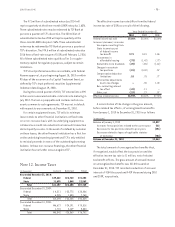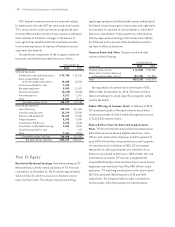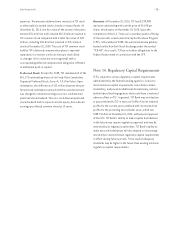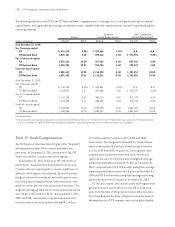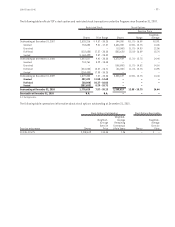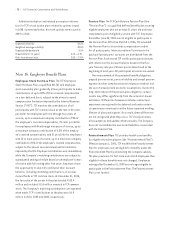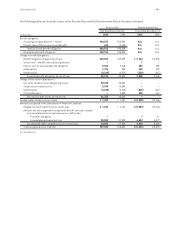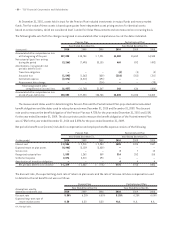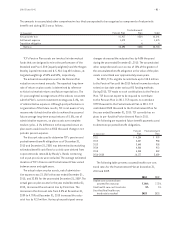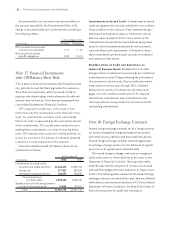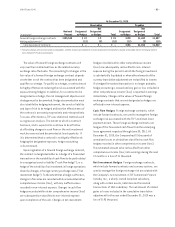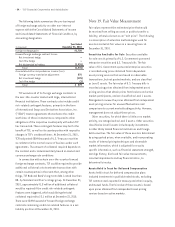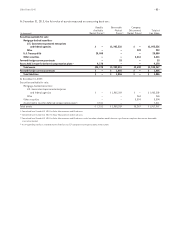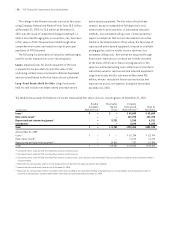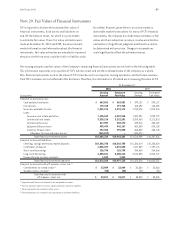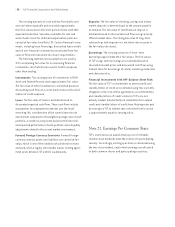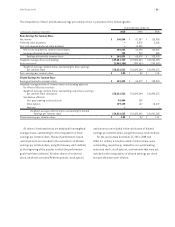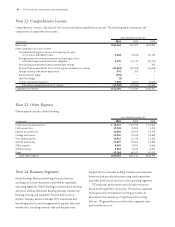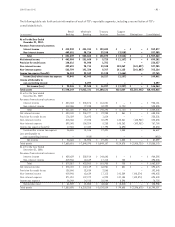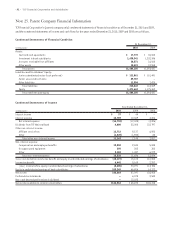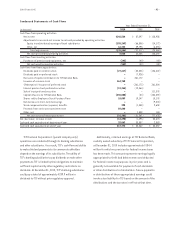TCF Bank 2010 Annual Report Download - page 99
Download and view the complete annual report
Please find page 99 of the 2010 TCF Bank annual report below. You can navigate through the pages in the report by either clicking on the pages listed below, or by using the keyword search tool below to find specific information within the annual report.
• 83 •
2010 Form 10-K
At December 31, 2010
Receivables Payables
Not Not
Notional Designated Designated Designated Designated
(In thousands) Amount as Hedges as Hedges Total as Hedges as Hedges Total
Forward foreign exchange contracts $185,540 $ 12 $ 3 $ 15 $198 $1,659 $1,857
Netting adjustments (1) (12) (3) (15) (12) (3) (15)
Carrying value of contracts $ – $ – $ – $186 $1,656 $1,842
(1) Foreign exchange contract receivables and payables, and the related cash collateral received and paid are netted when a legally enforceable master netting agreement
exists between TCF and a counterparty.
The value of forward foreign exchange contracts will
vary over their contractual lives as the related currency
exchange rates fluctuate. The accounting for changes in the
fair value of a forward foreign exchange contract depends
on whether or not the contract has been designated and
qualifies as a hedge. To qualify as a hedge, a contract must
be highly effective at reducing the risk associated with the
exposure being hedged. In addition, for a contract to be
designated as a hedge, the risk management objective and
strategy must be documented. Hedge documentation must
also identify the hedging instrument, the asset or liability
and type of risk to be hedged and how the effectiveness of
the contract is assessed prospectively and retrospectively.
To assess effectiveness, TCF uses statistical methods such
as regression analysis. The extent to which a contract
has been, and is expected to continue to be effective
at offsetting changes in cash flows or the net investment
must be assessed and documented at least quarterly. If
it is determined that a contract is not highly effective at
hedging the designated exposure, hedge accounting
is discontinued.
Upon origination of a forward foreign exchange contract,
the contract is designated either as a hedge of a forecasted
transaction or the variability of cash flows to be paid related
to a recognized asset or liability (“cash flow hedge”); or a
hedge of the volatility of an investment in foreign operations
driven by changes in foreign currency exchange rates (“net
investment hedge”). To the extent that a hedge is effective,
changes in fair value are recorded within accumulated other
comprehensive income (loss), with any ineffectiveness
recorded in non-interest expense. Changes in cash flow
hedges recorded within other comprehensive income (loss)
are subsequently reclassified to non-interest expense
upon completion of the sale. Changes in net investment
hedges recorded within other comprehensive income
(loss) are subsequently reclassified to non-interest
expense during the period in which the foreign investment
is substantially liquidated or when other elements of the
currency translation adjustment are reclassified to income.
If a hedged forecasted transaction is no longer probable,
hedge accounting is ceased and any gain or loss included in
other comprehensive income (loss) is reported in earnings
immediately. Changes in the values of forward foreign
exchange contracts that are not designated as hedges are
reflected in non-interest expense.
Cash Flow Hedges Foreign exchange contracts, which
include forward contracts, are used to manage the foreign
exchange risk associated with the TCF’s minimum lease
payment stream. These foreign exchange contracts are
hedges of the forecasted cash flows from the underlying
lease agreement expected through June 30, 2011. At
December 31, 2010, the Company had $1 thousand of
unrealized losses on derivatives classified as cash flow
hedges recorded in other comprehensive income (loss).
The estimated amount to be reclassified from other
comprehensive income (loss) into earnings during the next
12 months is a loss of $1 thousand.
Net Investment Hedges Foreign exchange contracts,
which include forward contracts and currency options, are
used to manage the foreign exchange risk associated with
the Company’s net investment in TCF Commercial Finance
Canada, Inc., a wholly-owned Canadian subsidiary,
along with certain assets, liabilities and forecasted
transactions of that subsidiary. The net amount of related
gains or losses included in the cumulative translation
adjustment for the year ended December 31, 2010 was a
loss of $195 thousand.


